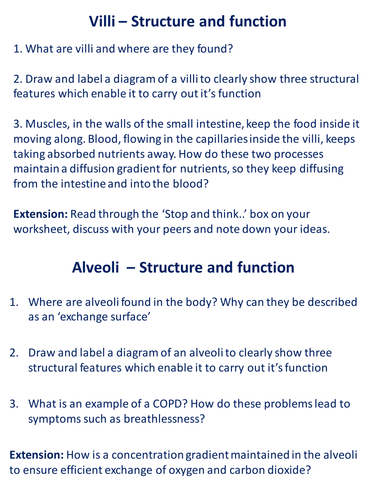



This resource is designed to meet specification points in the new AQA Trilogy Biology ‘Cells’ SoW.
For more resources designed to meet specification points for the new AQA Trilogy Biology, Chemistry and Physics specifications please visit my shop: https://www.tes.com/teaching-resources/shop/SWiftScience
This lesson begins with pupils shown a picture of an amoeba and one of a polar bear, they will need to discuss the difference between the organisms in terms of how they take in oxygen from their environment. Once you have shared a few ideas from the pupils with the class you can show the pupils the difference between the two organisms - amoeba can rely on simple diffusion whereas larger multicellular organisms need specialised exchange surfaces.
Pupils are then shown three examples of exchange surfaces - alveoli, small intestine and leaves of plants - they will need to think about how these structures might be adapted to exchange materials efficiently. You could have a short class discussion to develop these ideas.
Once you have again discussed these factors with the class you can reveal the next slide which outlines the 4 main features of an efficient gas exchange surface.
Pupils will then be given a worksheet and they will need to move around the room reading posters of information about villi and alveoli to complete the worksheet. This should take approximately 20 minutes, once finished pupils can peer-assess their work using the answers provided with the PowerPoint presentation.
The plenary is an Exit Card pupils will complete and pass to you on the way out of the door, this requires pupils to write down 3 key words, one fact and a question to test their peers knowledge of what they have learnt about in the lesson today.
Get this resource as part of a bundle and save up to 53%
A bundle is a package of resources grouped together to teach a particular topic, or a series of lessons, in one place.
Something went wrong, please try again later.
Doesn't completely follow AQA spec, misses out on fish gills and roots and leaves in plants. Spec specifically says: Students should be able to explain how the small intestine and lungs in mammals, gills in fish, and the roots and leaves in plants, are adapted for exchanging materials.
Fits in with the AQA specification regards to the . Good opportunity for the teacher to link this back to what they have learnt on diffusion
Report this resourceto let us know if it violates our terms and conditions.
Our customer service team will review your report and will be in touch.